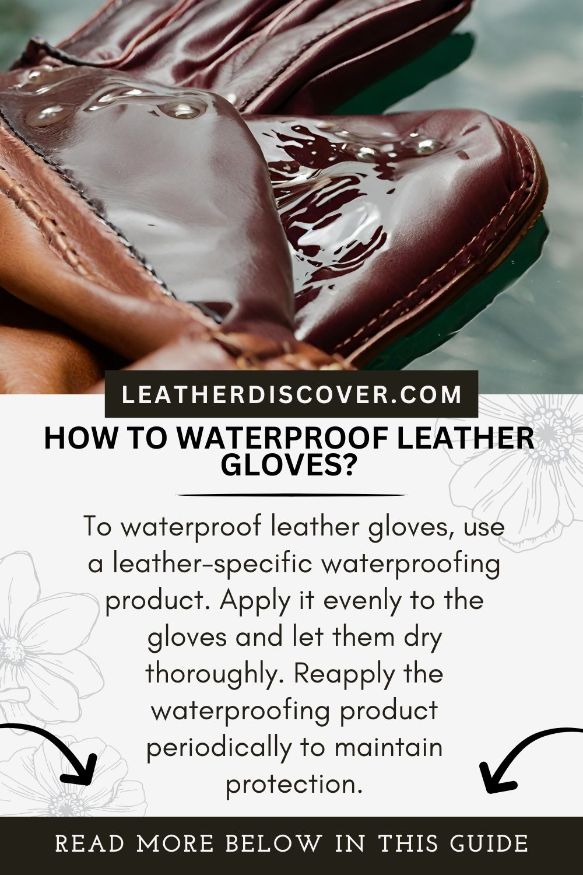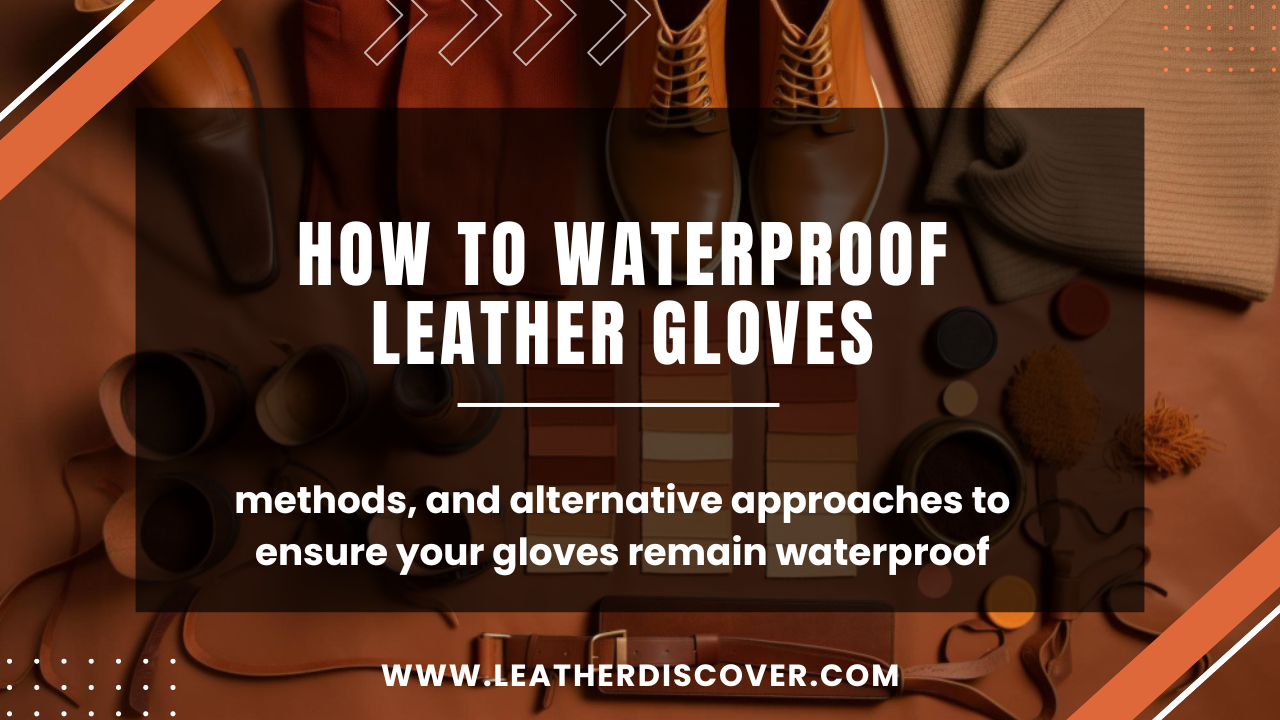Ensuring that your leather gloves remain in optimal condition, ready to provide both comfort and protection, is a matter of thoughtful care and maintenance.
Among the essential practices for safeguarding these versatile accessories, waterproofing stands as a pivotal step. The ability to shield your leather gloves from the ravages of moisture not only extends their lifespan but also guarantees that your hands remain dry and comfortable, regardless of the weather.
In this guide, we will explore why and how to waterproof leather gloves, methods, and alternative approaches to ensure your gloves remain waterproof.
[toc]

How to Waterproof Leather gloves?
To waterproof leather gloves, we will need:
- Leather waterproofing product (wax, cream, or spray)
- Soft cloth or sponge
- Hair dryer or heat gun (optional)
- Leather conditioner (optional)
Steps to waterproof leather gloves:
Here is how to waterproof leather gloves:
1. Clean the Gloves (if necessary):
Ensure that your gloves are clean and free of dirt, dust, and stains. If needed, gently clean them using a leather-specific cleaner and a soft cloth or sponge. Allow them to dry completely before proceeding.
2. Read the Product Instructions:
Check the instructions provided with the leather waterproofing product you plan to use. Different products may have specific application methods and drying times.
3. Apply the Waterproofing Product:
Using a soft cloth or sponge, apply a small amount of the waterproofing product evenly to the entire surface of the gloves. Ensure you cover all seams, creases, and stitching.
4. Allow for Absorption:
Let the gloves sit for a few minutes to allow the leather to absorb the waterproofing product. This will vary depending on the product; consult the instructions for specific guidance.
5. Heat Activation (Optional):
Some waterproofing products work better while waterproofing leather gloves when heat-activated. You can use a hair dryer or heat gun on a low setting to gently warm the gloves. This helps the leather absorb the product more effectively. Be careful not to overheat and damage the leather.
6. Reapply (if necessary):
For added protection, you may want to apply a second coat of the waterproofing product after the first coat has dried. Again, consult the product instructions for guidance.
7. Condition (Optional):
After waterproofing, consider applying a leather conditioner to keep the leather soft and supple. This step helps counteract any drying effects that some waterproofing products may have.
8. Allow to Dry Completely:
Ensure that the gloves are thoroughly dry before wearing them. This may take a few hours to a day, depending on the product and drying conditions.
9. Test the Waterproofing:
After the gloves have dried, test their waterproofing by sprinkling a few drops of water on them. If the water beads up and rolls off without soaking into the leather, the waterproofing is effective.
10. Regular Maintenance:
To maintain the waterproofing, periodically reapply the product, especially after heavy use or exposure to wet conditions.
By following these steps, you can effectively waterproof your leather gloves, providing them with protection against moisture and extending their usability in various weather conditions.
What Type of Leather Gloves Should I Waterproof?
Here are some types of leather gloves that are commonly waterproofed:
1. Outdoor Gloves:
Leather gloves designed for outdoor activities like hiking, camping, and skiing often benefit from waterproofing. These gloves are likely to encounter rain, snow, or moisture, making it essential to keep the hands dry.
2. Work Gloves:
Leather work gloves used in construction, agriculture, or other manual labor tasks can benefit from waterproofing. Waterproofing helps protect against wet conditions and ensures comfort during work.
3. Motorcycle Gloves:
Motorcycle gloves are exposed to various weather conditions while riding. Waterproofing keeps hands dry during rainy rides, making it an essential feature for motorcyclists.
4. Winter Gloves:
Leather winter gloves can also be waterproofed.
While many winter gloves have an outer waterproof layer, adding an extra layer of waterproofing to leather gloves helps them stay dry in heavy snow or slush.
5. Everyday Gloves:
If you wear leather gloves regularly and anticipate exposure to rain or wet conditions, it’s a good idea to waterproof them. This applies to fashion gloves as well as practical ones.
How Often Should I Waterproof My Leather Gloves?
The frequency of waterproofing your leather gloves depends on several factors:
- If you frequently use your gloves in wet conditions, they may require more frequent waterproofing.
- Seasonal changes and weather conditions also play a role. Waterproof gloves at the beginning of each season or before anticipated wet weather.
- Regularly inspect your gloves. If you notice that water no longer beads up on the surface and instead soaks into the leather, it’s time to reapply waterproofing.
Why Should You Waterproof Your Leather Gloves?
Waterproofing leather gloves is essential because it:
- Protects the gloves from moisture damage, preserving their quality and longevity.
- Keeps your hands dry and comfortable when wearing the gloves in wet conditions.
- Helps maintain the leather’s natural suppleness and appearance.
What Are Some Alternate Methods of Waterproofing Your Gloves?
Aside from commercial waterproofing products, you can also use natural options like beeswax or lanolin to waterproof leather gloves. These substances create a protective barrier on the leather.
However, it’s essential to test them in an inconspicuous area first to ensure they don’t affect the leather’s color or texture.
Do I Need to Waterproof Leather Gloves?
Waterproofing is recommended, especially if you anticipate that your gloves will encounter moisture.
Leather is naturally porous and can be damaged by prolonged exposure to water. Waterproofing not only protects the gloves but also ensures your hands stay dry and comfortable.
Is There a Spray to Make Leather Waterproof?
Yes, there are waterproofing sprays formulated specifically for leather.
These sprays create a protective barrier on the surface of the leather, helping it repel water. Look for reputable leather waterproofing products from trusted brands, and follow the application instructions on the product packaging.
Does Water Damage Leather Gloves?
Yes, water can damage leather gloves over time. Prolonged exposure to moisture can lead to several issues, including:
- Loss of natural oils, which can result in dryness and stiffness.
- Weakening of the leather fibers makes them more susceptible to tearing or stretching.
What to Do if Leather Gloves Get Wet?
If your leather gloves get wet, follow these steps:
- Blot the excess water with a clean, dry cloth. Do not wring or twist the gloves.
- Allow the gloves to air dry at room temperature. Avoid using direct heat sources, which can damage the leather.
- After drying, apply a leather conditioner to restore softness and suppleness.
- Ensure the gloves are completely dry before storing them to prevent mold or mildew growth.
Proper care, including waterproofing and handling wet gloves correctly, can help prolong the life of your leather gloves and maintain their appearance.
Conclusion:
So, now you know how to waterproof leather gloves.
Waterproofing leather gloves is a crucial aspect of their care and maintenance.
By taking the time to protect your gloves from moisture, you not only extend their longevity but also ensure they continue to provide the comfort and protection you rely on, regardless of weather conditions.
Whether you opt for commercial waterproofing products or natural alternatives, the goal remains the same: to preserve the quality and appearance of your leather gloves while enhancing their ability to keep your hands dry and comfortable. With proper care, these timeless accessories will continue to serve you well, year after year.
- What Is Caiman Leather? A Detailed Guide - July 25, 2024
- What Is Tumbled Leather?A Complete Guide - July 25, 2024
- What Is Kip Leather? Premium Leather Choice - July 24, 2024

